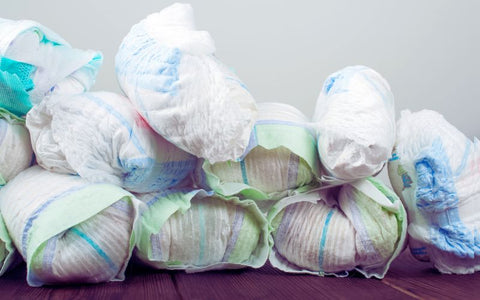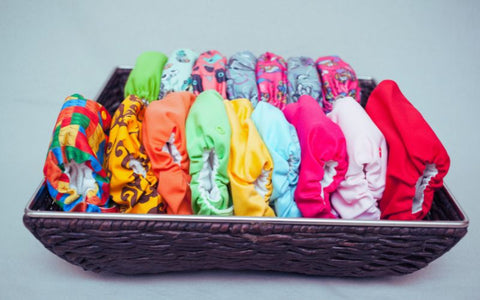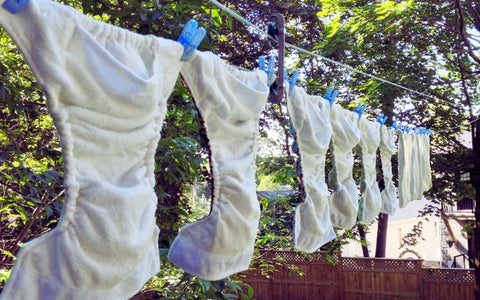
Types of diapers and how to use them
When you have your first baby, you may be wondering what kind of diapers to choose. If you don't have any experience in this field yet, you probably want to learn about the things to pay attention to when changing diapers and the correct way to do it.
Now we will help you navigate these issues.
The process of diapering
The main rules for diapering a newborn are not very different from those for an older baby. The difference is primarily due to the presence of an umbilical stump.
Diapering a newborn
The number one rule is to never leave your baby alone on the changing table, always hold them with at least one hand!
In this case, it is enough to undress the baby from the bottom. First, treat the umbilical stump according to the current recommendation. Then fold the diaper back so that you can wipe the bottom with the front part, so you need to use less diaper wipes. Fold the diaper under the baby's waist, and then you can wipe. Start with the groin folds, then wipe all the dirty areas. Always work from front to back! We will discuss the cases of girls and boys separately below.
Meanwhile, hold the baby's feet with the so-called fork grip, as you can see in the picture:

After wiping clean, remove the soiled diaper and place the new one underneath, making sure it is high enough to protect the waist area so that the contents do not leak out the back. If the skin is red, apply a butt cream (preferably one made with natural ingredients). Apply to the groin and bottom, avoiding the labia majora for girls and the penis for boys.
The umbilical cord should not be covered by the diaper, it needs to be ventilated. Newborn diapers are usually not high on the abdomen, and disposable ones should be folded at the abdomen so that the umbilical cord remains exposed.
Extra Tip from Mothers to Mothers:
Always turn the pleats inside out, otherwise there is a greater chance that the contents of the diaper will leak through the pleats.
Diapering a little girl
It is difficult to change a baby girl's diaper if there is stool between the labia majora. This must be cleaned very carefully so as not to push the dirt into the vagina or the urethral opening. Therefore, wipe it slowly from the inside out or from top to bottom. If you need to apply cream, do not let it get into the vagina or urethral opening.
Diapering a little boy
Here we have a little easier. The foreskin should not be pulled back with force, especially not in newborns, because it is still attached and can cause injury. Only apply the cream to the groin and buttocks if necessary. When you put the clean diaper on him, make sure that the penis is facing down so that he does not pee out of the diaper.
Now let's move on to the types of diapers, as some of them should definitely be purchased even before the baby is born.
What types of diapers can we choose from?
If you are not looking for diapers for your first child, this summary may still be useful to you. It is common experience that a certain type of diaper works great for one child, but not at all for the sibling, so you have to look for new options.
We would like to emphasize that we will not be advertising diapers, nor will we mention brands here. We trust that knowing your own options and values will make your choice easier based on our article.
Since you may not find the ideal type the first time, it's a good idea to get a few of several types and try them out. The one that works best for you can be purchased later. This way, you can avoid wasting money on a larger supply of diapers.
Basically, we can classify diapers into two large groups: disposable and washable.
Let's look at the disposable types first! But we're not starting with them because we recommend them, but because this section will be shorter. (We'd also like to share more information about how to care for washable ones, and there are several types of them.)
Disposable diapers – they have many disadvantages, but there are times when it is difficult to choose otherwise
Washable diapers are clearly more economical, environmentally friendly and skin-friendly.
But there are situations where you might prefer disposables. For example, if the mother doesn't have much help and has health issues that make housework, including laundry, a burden for her.
This may also be the more acceptable choice if the apartment is very small, there is no dryer and there is no possibility of hanging clothes outside, so in order to avoid wall mold, we try to save on washing. In this case, it is better to get a dryer if we can, because we will have to wash anyway, and not a little... This way, washable diapering will also become available, which, even with a little more electricity and water consumption, has a smaller environmental impact.
There are also situations when we temporarily opt for disposable diapers, for example due to a trip or a hospital stay.
Why are disposable diapers not environmentally and skin-friendly?
- Their major disadvantage is that they generate a significant amount of plastic waste. It is better to choose natural materials, such as corn fiber or bamboo, but it is worth knowing that these also have non-degradable parts and mainly only decompose in industrial composters.
- Most of them are treated with various chemicals that can irritate the baby's skin. Plastic diapers are less breathable, which is also not good for sensitive skin.
- Many people find that when using disposable diapers, the baby feels less that he has wet himself, making it more difficult for him to become potty trained later.
- It is also striking that odors persist in the apartment even if we empty the trash frequently.

Is there any advantage?
We can mention only one advantage: we don't have to deal with it, we don't have to dry it either, which can be helpful in the situations mentioned above. In such cases, it is worth looking for types that consist of a significant part of biodegradable materials. But unfortunately, this is also misleading: in fact, only 60-80% of the material of such diapers decomposes, and even then only in an industrial composter, so it will just end up as garbage in a landfill. Obviously, they are a bit better than the completely plastic versions, but unfortunately, here too we have to take into account the environmental impact.
Pay attention to this.
Make sure it is the right size: it should fit snugly around the thighs and be high enough around the waist to prevent the contents from squeezing out. If this happens frequently, you can be sure that the size or type needs to be replaced.
The world of washable diapers
- As mentioned above, using washable diapers has a much smaller ecological footprint, meaning there is much less environmental impact. There is no waste generated.
This way, you need slightly more electricity and water to wash, but it's worth knowing that the disposable versions use significantly more water, energy, and chemicals to produce. So, from this perspective, the environmental impact is also lower.
- Another advantage is that it is well ventilated and the baby's skin does not get hot or stuffy. This means you don't have to worry about irritation if you change diapers frequently.
- They are more economical to use, and even with the cost of washing, the total cost is much less. This is especially true if you consider that you can sell them later or pass them on to a sibling.
- Babies with wet diapers usually become housebound sooner.

We recommend that you always have some disposables at home in case of need, which do not need to be used up, but there may be situations where there is no other choice.
It may seem like a disadvantage to have to wash clothes, but with a well-established routine and, of course, the help of a washing machine, this doesn't take up as much time and energy as it did in our grandmothers' time. Let's talk a little about keeping them clean.
Washing the diaper
Most recommend washing them at least every two days to prevent bacteria from growing.
Obviously, we don't throw them into the machine as they are, but prepared: the feces need to be removed, that belongs in the toilet. Many people use, for example, an old bank card or a similar, non-damaging scraping tool. Do this immediately after changing the diaper.
After this, we can use two methods:
- We rub the diapers in warm sodium percarbonate water. It is also recommended to rinse the diapers this way. Use rubber gloves for this, because when the active oxygen is released from the sodium percarbonate (which kills stains and bacteria), it will irritate and damage your skin. Which is why it is environmentally friendly: after this stain-destroying reaction takes place, no harmful chemicals are produced, and you can safely pour the water down the drain afterwards. It is also often marketed as stain-removing salt, which is how you may encounter it.
- The other method (if you don't want to bother with this and are inclined to do it, or maybe you have a health reason): you can solve the same problem by pre-washing: put the diapers in the machine, put sodium percarbonate in the washing machine drum, and then start the pre-wash. In this case, the disadvantage is that you will consume more electricity. However, for an overworked mother (especially if she doesn't have enough help), this is often the ideal solution. And even then, the environmental impact is much lower than with disposable diapers.
And now comes the main wash itself:
- Many people consider washing at 40 degrees Celsius sufficient. It is important to use plenty of water and not on the water-saving program, as in this case a thorough rinse is especially necessary.
Sometimes, especially after an illness, it is necessary to wash at 60 degrees. Some people always set a 60 degree program if the diaper material allows it.
You can also, and this may be necessary especially when washing at 40 degrees, use a diaper disinfectant occasionally.
- Don't use fabric softener, as it will ruin the diaper's absorbency. However, you can use vinegar instead.
- Spinning faster than a thousand revolutions can ruin the diaper material, so check the value set on your washing machine!
Let's also say a few words about drying.
It's best to let the diapers dry outside in the sun. Sunlight also has a stain-fighting effect, and you don't need to use electricity to do it.

But we know that not every family can handle this. In a small apartment, where there is no balcony or it is unsuitable for drying, this is obviously not an option. The same is true in winter or in bad weather. In such cases, a dryer can come in handy. If we hang too many clothes in the apartment, the walls become moldy more easily, which poses health risks.
Types of washable diapers
Now comes the confusion of abundance. There are as many kinds as there are stars in the sky... You can also choose from popular brands. But there are many small business moms who make excellent diapers, and you can support them by buying them.
Since each baby will need a different type, it is recommended that you don't buy everything before the birth, but rather buy 1-2 of several types. As you go, you will find out which one is ideal for you, and you can buy more of it later.
One-size diapers probably won't be enough for a newborn baby, so look for newborn versions! If you don't want to spend a lot of money on them for this short period of time, you can rent diapers or sell them later.
So, according to size, there are:
- newborn diapers,
- one-size, more precisely adjustable diapers,
- they are multi-dimensional.
According to structure, the main types are as follows:
- All-in-one diaper : in this case, the waterproof outer layer is sewn together with the inner absorbent layer. This must be replaced in its entirety every time.
- Pocket diaper: similar to the previous one, but here the absorbent inner layer and extra layers are placed in a pocket connected to the outer layer. Here too, the whole thing needs to be replaced.
- Boat diaper: the boat-like waterproof layer is placed inside the cotton outer layer, and the absorbent inner layer is inside. If the boat or the outer layer is not soiled with feces, then only the inner layer needs to be changed. Many people consider it one of the most “accident-free” types, but it is not at all certain that this will work for you.
- Diaper inner plus outer: the absorbent inners should be placed in a waterproof outer layer, you can even boost it with extra layers. You will most likely need this solution at night.
Diaper covers are now made of breathable materials. These are mostly not natural, but they are durable. There are also wool covers, but these require more special treatment: they need to be lanolined, and cleaning also requires more attention due to the sensitivity of the material. However, some people prefer this.
Diaper liners can also be varied: there are pre-formed liners, there are "semi-" prepared, prefold diaper liners, and we can also use the classic tetra diaper.
As you get closer to potty training, weaning pads can be useful, as they resemble panties and can be pulled off and put back on by your child. These no longer have a thick absorbent layer, but are only suitable for preventing major accidents.
How to match your baby's clothes to their diapers? H2
Anyone who has tried several types of diapers may have noticed that there are cases when you need to use a different size of cloth than you might initially think is logical.
For disposable diapers, choose the size as you would normally: according to the length of your baby's body.
Most washable diapers form a slightly thicker package on the baby's bottom, especially the nighttime versions. Therefore, in this case, a one-size-larger bodysuit and kicker will be more comfortable for your baby. It is also possible that the normal size will still be fine for daytime diapers, but you will need the larger size for nighttime diapers. This is something you have to experiment with.
You can also get body extension clips, you can try these too.
Just as it is worth paying attention to the material of the diaper to ensure that it is well ventilated, the clothes should also be skin-friendly. That is why we heartily recommend baby clothes made of bamboo, which are soft and gentle.
We've pretty much covered the different types, now let's get to how to diaper. If you're expecting your first baby, it's definitely worth reading on. But if you're having a baby girl after a baby boy, or vice versa, this brief description may still be important to you, as there are some differences.
Funny cases...
We tend to laugh about these things in hindsight. When they happen, we may not be happy... Especially in the newborn age, it can happen that your baby poops or peees while you are changing your diaper. It could also happen that he is about to hit you. The point is that safety comes first, don't change yourself first, and don't leave your baby alone on the changing table for a while!
Has anything like this ever happened to you? If you'd like, share it with us!
































